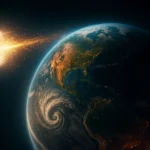Space may look calm and quiet, but it’s far from safe. All around our planet — and across the solar system — there are dangerous objects flying at insane speeds, many of them invisible to the naked eye.
Some of these could damage satellites. Others might crash into Earth. And some are just plain terrifying because we don’t fully understand them yet.
So, what are the top 10 most dangerous things floating in space right now?
1. Space Junk (AKA Orbital Debris) 🛰️💥
There are over 100 million pieces of space junk orbiting Earth — everything from broken satellites to bolts, paint chips, and even tools dropped by astronauts.
Even something as small as a screw becomes deadly at 28,000 km/h. Just one collision can destroy a working satellite or even threaten astronauts on the International Space Station (ISS).
Why it’s dangerous:
- High-speed collisions
- Can trigger chain reactions (like the Kessler Syndrome), where debris causes more debris
- Hard to track and avoid
2. Dead Satellites 🛰️⚰️
Thousands of non-working satellites still orbit Earth. They’re useless now — but still big and heavy, and moving fast.
Some are school-bus sized. If one of them crashes into another satellite or space station, it could create thousands of new fragments of debris.
Why it’s dangerous:
- Massive in size
- Can fall to Earth unpredictably
- Can spark massive debris fields
3. Defunct Rocket Stages 🚀🪨
After rockets launch satellites or space probes, their leftover stages sometimes remain in orbit. These giant metal tanks and boosters float in space — often uncontrollable and full of fuel vapor.
Some have exploded in the past. Others are still up there, slowly drifting.
Why it’s dangerous:
- Big, heavy, and unpredictable
- Can explode if pressure builds inside
- Not designed to stay in space forever
4. Micrometeoroids ☄️⚠️
Tiny rocks from space — sometimes no bigger than grains of sand — move at speeds up to 70,000 km/h. They’re too small to track, but powerful enough to puncture a satellite or spacecraft.
The ISS gets hit by these frequently, and even its windows show damage from micrometeoroid strikes.
Why it’s dangerous:
- Impossible to track
- Travel faster than bullets
- Can tear through metal, electronics, or astronaut suits
5. Nuclear-Powered Spacecraft ☢️🛰️
Some old satellites — especially from the Cold War era — were powered by nuclear reactors. If one of these falls to Earth and survives reentry, it could spread radioactive material over large areas.
In fact, one Soviet satellite (Kosmos 954) crashed in Canada in 1978, leaking radioactive debris.
Why it’s dangerous:
- Contains radioactive materials
- Risk of contamination if it crashes
- Many of them are aging and unstable
6. China’s Long March Rocket Debris 🚀🇨🇳
China’s Long March rockets have re-entered Earth’s atmosphere uncontrolled multiple times — meaning no one knew exactly where they would land.
In 2020 and 2021, large metal parts from these rockets crashed near villages in West Africa and Southeast Asia. No one was hurt, but the risk remains.
Why it’s dangerous:
- Massive chunks of metal falling from space
- Completely uncontrolled descent
- Could crash into cities or populated areas
7. Uncontrolled Reentry Events 🌍🔥
Sometimes, entire satellites or rocket parts fall back to Earth — without warning. Although much of it burns up in the atmosphere, larger pieces can still survive and crash on land or in oceans.
While space agencies try to predict these events, they’re often only known hours before impact.
Why it’s dangerous:
- No accurate landing prediction
- Can injure people or damage property
- Increasing in frequency
8. Asteroids Near Earth 🪨🌌
There are thousands of asteroids that come close to Earth every year. Most are harmless and small, but some are large enough to cause regional or global damage if they hit.
NASA tracks them constantly. The biggest threat? The ones we haven’t found yet.
Why it’s dangerous:
- Can cause mass extinction (like the dinosaur killer)
- Some move faster than we can deflect
- Many still undetected or poorly tracked
9. Fuel Tanks Still Full of Toxic Chemicals 🧪🚀
Some satellites and rocket parts still contain unused fuel — often highly toxic or explosive. In space, this fuel might leak or react over time, causing random explosions.
These explosions add more debris, and the chemicals can corrode or damage nearby hardware.
Why it’s dangerous:
- Leaks toxic chemicals
- Can explode
- No way to remove or stabilize them once in orbit
10. Mystery Objects and Classified Tech 🤫🛰️
Not everything in space is public knowledge. Some governments (especially the US, China, and Russia) have military satellites, spy tech, and experimental vehicles floating in orbit — and not all of it works properly.
There are even reports of unknown objects that don’t match normal satellite behavior.
Why it’s dangerous:
- Unknown capabilities
- No public data on tracking
- Could interfere with civilian satellites
So, Should We Be Worried?
Yes and no.
Many space agencies, like NASA and ESA, work around the clock to track space debris, avoid collisions, and prevent disasters. Satellites today are built with shields or backup systems to handle small impacts. Even the ISS can dodge larger threats by adjusting its orbit.
But as more satellites launch each year, space is becoming crowded and chaotic. Companies like SpaceX, Amazon, and others are launching thousands of satellites for internet and communication — adding to the risk of collisions.
Final Thoughts 🌌
Space might look peaceful, but it’s filled with hidden dangers flying at deadly speeds. From space junk to nuclear debris and rogue asteroids, Earth’s orbit is becoming more and more like a giant cosmic traffic jam.
The good news? With better tracking, smarter tech, and global cooperation, we can reduce the risks and keep both our planet and space future safe.
But one thing’s for sure — the sky above isn’t empty. It’s filled with danger.


